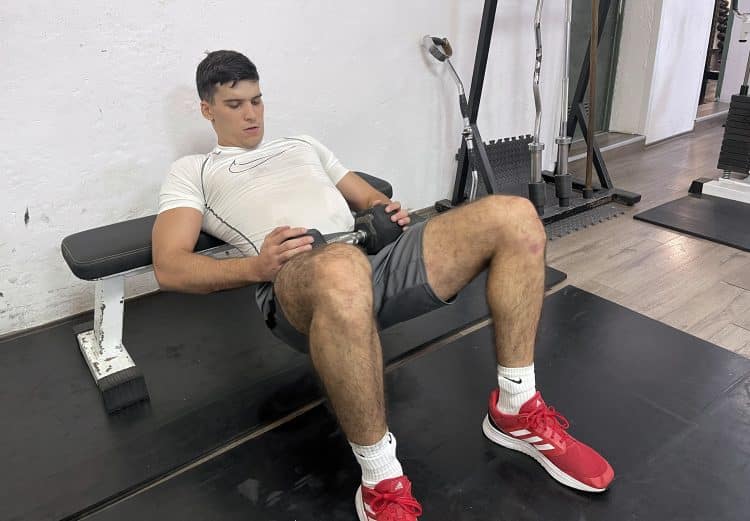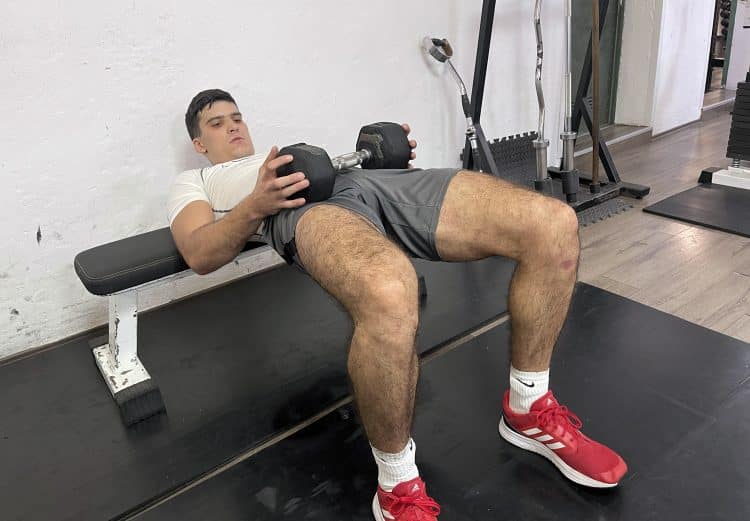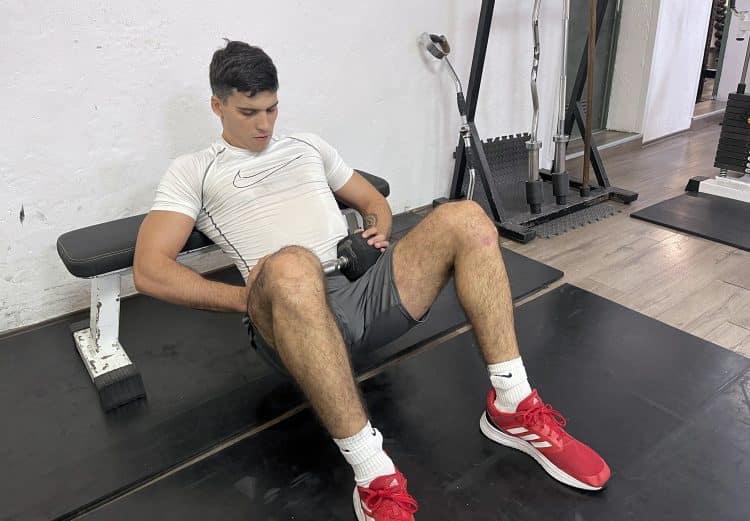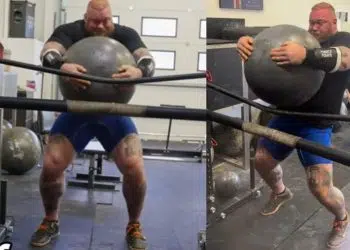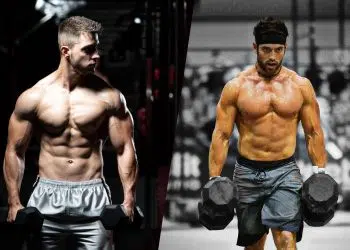Many lifters believe the only way to build a bigger and stronger posterior chain is by performing countless heavy barbell squats and deadlifts. While these two exercises are very efficient at inducing muscle hypertrophy and gaining strength, you shouldn’t limit yourself to these.
The dumbbell hip thrust is an incredibly effective (and unintimidating) exercise to develop glutes and hamstrings and is slowly but surely gaining traction in the fitness community.
In this article, I compiled everything you need to know about the dumbbell hip thrust into an easy-to-follow guide so you learn the proper exercise form to get the best bang for your buck. This article also covers the muscles worked, exercise benefits, and dumbbell hip thrust alternatives.
How to Perform a Dumbbell Hip Thrust: Step-By-Step Guide
Follow the steps below to master the dumbbell hip thrust form, avoid potential injuries, and maximize exercise efficiency:
Step One — Set Up Everything
Place a dumbbell of an appropriate weight on the floor beside a weight bench. Sit on the floor on the same side as the dumbbell with your back against the bench’s side. Feel free to place an exercise mat on the bench’s edge to keep it from digging into your back. The bench should be of appropriate height; your shoulder blades should be resting against the bench’s edge while you’re seated on the floor. Shorter folks will be better off using a smaller plyo box instead of a weight bench.
Level Up Your Fitness: Join our 💪 strong community in Fitness Volt Newsletter. Get daily inspiration, expert-backed workouts, nutrition tips, the latest in strength sports, and the support you need to reach your goals. Subscribe for free!
Pro Tip: Choose a dumbbell weight that challenges you but allows you to maintain proper form throughout the exercise. Starting with the right weight is crucial for a safe and effective hip thrust.
Step Two — Enter the Starting Position
Place the dumbbell horizontally in your hip crease and hold onto each end to ensure it stays in place. Plant your feet shoulder-width apart on the floor and turn your toes outward slightly. Get into the starting position by lifting your hips a few inches off the floor.
Pro Tip: To ensure stability during the exercise, engage your core muscles by actively pulling your navel toward your spine. This will help protect your lower back and enhance your balance.
Step Three — Start the Thrust (Concentrics)
Thrust your hips towards the ceiling using your glutes and hamstrings. Your body, from the knees to the head, should be in a straight line at the top of the range of motion (ROM). Pause at the isometric contraction point at the top. Ensure a full range of motion for maximal muscle fiber recruitment.
Pro Tip: Squeeze your glutes in the fully shortened position. This contraction helps maximize the activation of your glutes, promoting hypertrophy. Also, always use the first hip thrust rep to check your form. If your lower and upper legs are not perpendicular at the top of the range of motion, readjust your feet.
Step Four — Return to the Starting Position
Slowly lower your hips towards the floor. Employ deliberate eccentrics as they increase the time under tension, resulting in hypertrophy and strength gains. Lower until your butt is just above the ground. Repeat for recommended reps.
Pro Tip: Focus on your breathing throughout the movement. Inhale as you lower your hips and exhale as you thrust them up. This controlled breathing pattern can help you maintain stability and control and develop a mind-muscle connection.
What Muscles Do Dumbbell Hip Thrusts Target?
The hip thrust primarily targets the gluteus maximus [1]. It is mainly responsible for hip extension. In addition to the gluteus maximus, gluteus minimus and gluteus medius also help with the hip extension movement.
Here are the secondary target muscles:
- Hamstrings: These include the biceps femoris, semimembranosus, and semitendinosus muscles located at the back of your upper leg. These assist the glutes in extending the hips during the concentric phase of the exercise.
- Erector spinae: This muscle is located across the full length of your spine, specifically between parts of the vertebrae called transversus spinosus and processus spinosus. This muscle is responsible for providing stability to your lumbar spine and helps with proper posture during movement.
- Adductors: The inner thigh muscles include the adductor magnus, adductor brevis, adductor longus, gracilis, and sartorius. These play a secondary role in stabilizing your legs during hip thrusts, specifically in the frontal plane. Think in terms of maintaining proper floor placement and overall stance.
- Quadriceps: Four quad muscles include rectus femoris, vastus medialis, vastus lateralis, and vastus intermedius. All these muscles are inserted at the tendon and tied to one of the smallest sesamoid bones in the body, called the patella. However, only the rectus femoris of all four muscles originates at the hip bone (os coxae), making it a biarticular (two-joint) muscle. The rest of the quad muscles originate at the upper portion of the femur bone, making them only responsible for the knee. Quads, in this case, are primarily responsible for stabilizing the knees during the hip thrust motion.
Dumbbell Hip Thrust Benefits
Below are the most important dumbbell hip thrust benefits you should know.
Stronger Glutes
Dumbbell hip thrusts will effectively build your glute muscles, such as gluteus maximus, medius, and minimus. This is why hip thrust is such a powerful alternative for barbell squats and deadlifts.
Improved Hip Strength
Strengthening your glutes and other surrounding muscles will improve your hip strength. This will result in greater postural stability in all three planes of motion — sagittal, frontal, and transverse. This is also very important for athletes participating in activities that include horizontal displacement. [2]
Level Up Your Fitness: Join our 💪 strong community in Fitness Volt Newsletter. Get daily inspiration, expert-backed workouts, nutrition tips, the latest in strength sports, and the support you need to reach your goals. Subscribe for free!
Reduced Lower Back Pain
You will reduce the chance of lower back injury and pain by strengthening your glutes and the rest of the posterior chain muscles, such as the hamstrings and erector spinae. This is because these muscles are responsible for holding your spine in place, reducing the chance of postural instability and, therefore, pain and injury.
Enhanced Posture
You will significantly enhance your posture and build a strong foundation by strengthening your posterior chain. Posture mainly depends on posterior and anterior muscles surrounding the hip, and hip thrusts target 50% of these muscles.
Injury Prevention
Strong posterior chain muscles represent a foundation for a healthy back, especially your lumbar spine. Since hip thrusts effectively target these muscles, you will significantly decrease the chance of injury.
Dumbbell Hip Thrust Alternatives and Variations
Below are the best dumbbell hip thrust variations and alternatives you should consider:
Bodyweight Double-Leg Hip Thrust
Beginners should drill the hip thrust movement mechanics with the bodyweight double-leg hip thrust.
Steps:
- Sit with your back against a bench and rest your shoulder blades on it.
- Put your hands on the bench for extra support, and assume a hip-width stance.
- Thrust your hips toward the ceiling
- The angle between your tibia and femur should be approximately 90 degrees.
- Slowly lower your hips towards the ground.
- Repeat for recommended reps.
- Make sure to extend your hips at the top maximally.
Pro Tip: To increase the intensity, pause at the top of each rep for a few seconds and squeeze your glutes as hard as possible before lowering your hips back down.
Bodyweight Single-Leg Hip Thrust
Bodyweight single-leg hip thrust is a more challenging variation of the previous exercise, but it is still a regression compared to the dumbbell version.
Steps:
- Sit against a bench and rest your scapula (shoulder blades) on it.
- Plant your feet shoulder-width apart on the floor.
- Lift your left foot off the floor and tuck your left knee toward your chest.
- Drive your hips toward the ceiling and pause at the top of the range of motion.
- Slowly return to the starting position.
Pro tip: To enhance balance and stability, keep your core engaged and your hips level throughout the range of motion.
Barbell Hip Thrust
Perform the barbell hip thrust after mastering dumbbell hip thrusts. You can use heavier weights on this exercise to achieve better leg power, strength, and muscle hypertrophy results.
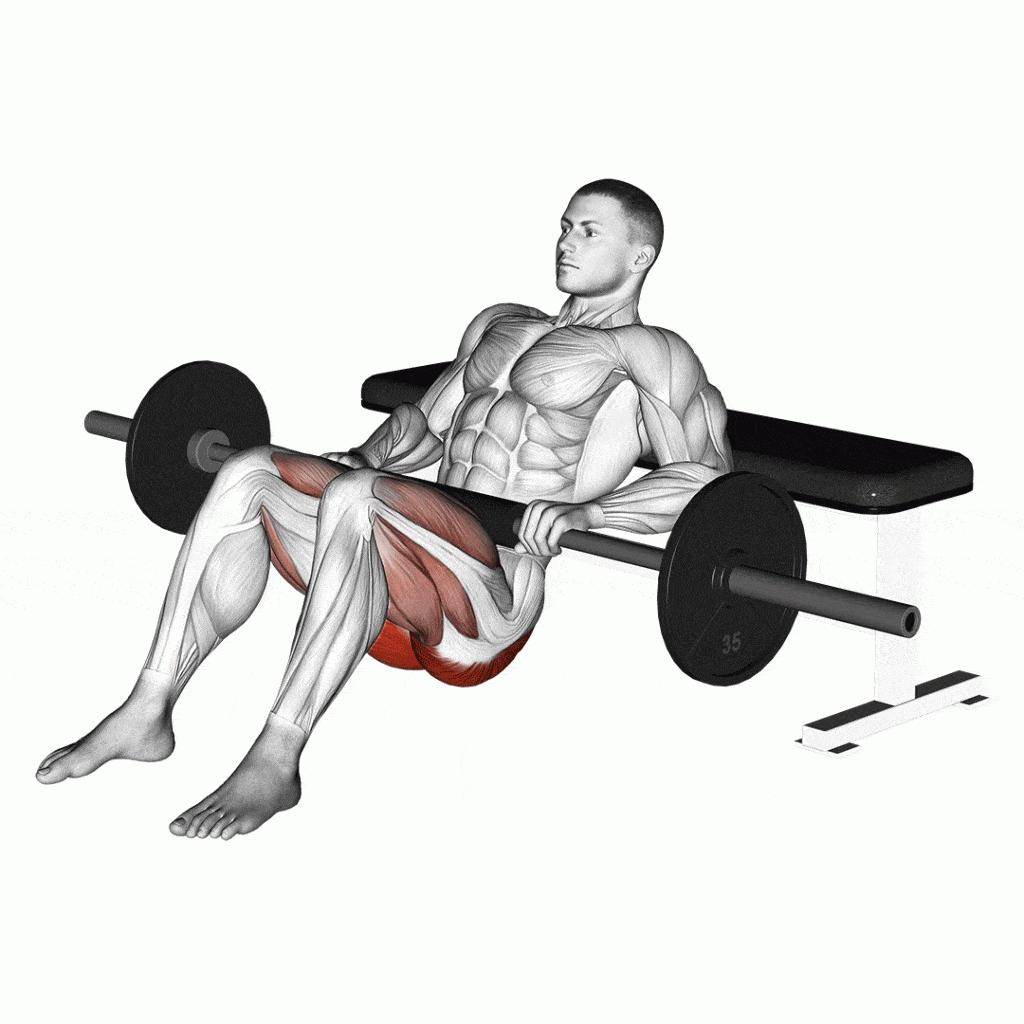
Steps:
- Load the barbell on the floor with the appropriate weight so you can perform the desired number of reps unbroken.
- Sit against a bench and rest your shoulder blades on it.
- Roll the barbell over your legs and position it over your hip crease.
- Assume a hip-width stance and turn your toes outward slightly.
- Raise your hips toward the ceiling.
- Reverse the motion to return to the starting position and repeat the whole process for the recommended number of reps.
- Avoid touching your butt to the floor during eccentrics.
Pro Tip: Use a barbell pad or wrap a towel around the bar to minimize discomfort.
Read more details on hip thrust exercise.
FAQs
How much should I hip thrust with a dumbbell?
How heavy you should lift on the dumbbell hip thrust depends on several factors, including your current fitness level, weight, age, and gender. Beginners should focus on drilling the movement mechanics instead of chasing big weights. Increase the weights progressively to ensure you’re not compromising exercise form.
How many reps should I do for dumbbell hip thrust?
The number of reps you should perform on this exercise will depend on your training goal. People training for muscle endurance should perform between 12 and 25 reps. For hypertrophy, between six and 12 reps has been shown to yield the most significant muscle-building results. For strength, anything between one to six reps will do.
How much can a beginner hip thrust?
It will vary for each individual, depending on their gender, age, weight, and experience level. Beginners should start with bodyweight hip thrusts to learn proper form before transitioning to the weighted version of the exercise.
Do hip thrusts have to be heavy?
No, hip thrusts don’t have to be heavy. If you aim to improve your muscle endurance, high repetitions with lighter weights will do. You must use heavier weights to build strength since that is the only way to fire up all motor neurons and fast twitch fibers.
Wrapping Up
The dumbbell hip thrust is an excellent squat, deadlift, and barbell hip thrust alternative to help you build a robust posterior chain. Dumbbell hip thrusts are incredibly effective for improving aesthetics, maximizing performance, and avoiding potential injuries.
In the comments below, let me know your biggest challenges when performing dumbbell hip thrusts, and I’ll do my best to help you.
References
- Brazil A, Needham L, Palmer JL, Bezodis IN. A comprehensive biomechanical analysis of the barbell hip thrust. PLoS One. 2021;16(3):e0249307. Published 2021 Mar 29. doi:10.1371/journal.pone.0249307
- Neto WK, Vieira TL, Gama EF. Barbell Hip Thrust, Muscular Activation and Performance: A Systematic Review. J Sports Sci Med. 2019;18(2):198-206. Published 2019 Jun 1.
Interested in measuring your progress? Check out our strength standards for Deadlift, Hip Extension, Hip Thrust, and more.


